 |
| December 05, 2017 | Volume 13 Issue 45 |
Designfax weekly eMagazine
Archives
Partners
Manufacturing Center
Product Spotlight
Modern Applications News
Metalworking Ideas For
Today's Job Shops
Tooling and Production
Strategies for large
metalworking plants
Engineer's Toolbox:
Moisture Intrusion Detection System: Solving water leak inspection challenges on vehicle assembly lines
By ON Semiconductor
The Problem:
Water Intrusion is Costly -- Recalls, Repairs, Brand Reputation
"Water Leaks" have plagued the auto industry for years. About 3% of new vehicles leave the factory with leaks large enough to cause mold growth and damage to expensive electronic components. Detecting assembly issues and the leaks they trigger before a vehicle leaves the factory is critical to improving outgoing quality and avoiding customer warranty issues that lead to costly recalls.
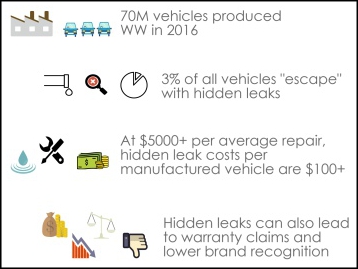
Water is a surprisingly powerful tool for finding assembly defects or material shortfalls. However, even with the best traditional efforts of today's manual inspection procedures, small leaks can go undetected. These small leaks are then often discovered only after vehicles are purchased. This, combined with the fact that today's vehicles are built with new materials including aluminum, composites, glues, and feature hundreds of electronic sub-assemblies, makes vehicles more susceptible to water damage than ever before. This can be seen by the growing number of leak-related warranty claims, with at least 500,000 vehicles recalled1 in the last three years.
The Existing Industry Process
Most automakers utilize a 2- to 5-minute vehicle soak test at the end of the assembly line to verify a "dry" vehicle as part of their final quality acceptance process. During the soak test, vehicles are sprayed with water pressures as high as 2,000 psi. Multiple angled jets accelerate any leak conditions.
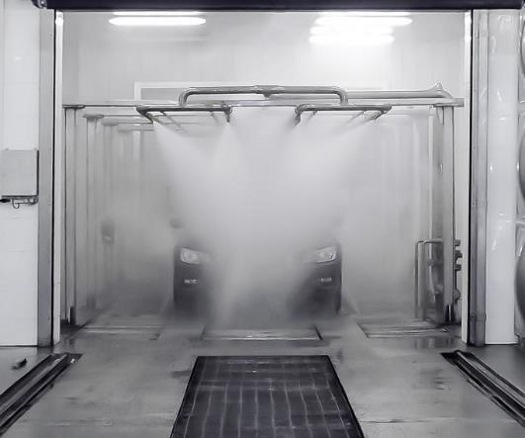
Figure 1. Automakers turn up the pressure to find leaks with water jets in the 2,000 psi range.
After the soak test, the vehicle is physically inspected by line workers. Traditional manual inspection methods detect the water that can be seen visually or felt by the worker's hands. This method leaves much to be desired because smaller leaks and those hidden in inaccessible areas are both easily missed. Water easily pools in hard-to-reach areas, which are often behind plastic trim pieces or underneath carpet.
Existing inspection methods miss leaks and force increased "touching" of the vehicles, which increases cost.
Other manual inspection methods tend to be very labor intensive. Some of the more common approaches are handheld probes that electrically identify leaks when water shorts the contacts, chemically impregnated paper indicator tapes that change color when exposed to water, and the removal (and subsequent re-installation) of various trim pieces for visual leak inspections. With the increasing use of thick sound-dampening foam and large cable harnesses underneath the carpet, even these options have proven to be unreliable.
The Solution
Catching leaks at the factory requires a new approach to leak detection. Since getting to the leak areas is challenging, what's needed are water sensors located in these locations, under the carpet and in the thin spaces between plastic panels and door moldings.
A cost-effective, reliable system that accurately verifies if a vehicle is wet or dry is invaluable to automakers.
ON Semiconductor and RFMicron have taken up this challenge, with a two-fold leak detection solution (Figure 2). The first part utilizes thin, unobtrusive moisture sensors that are placed where the water pools without affecting or displacing other components or trim pieces. The second part is a system to read these sensors and then aggregate that sensor data to determine where leaks are located. With specific leak location data, automakers can repair leaks faster and then turn their sophisticated quality control systems to identifying the root causes of the leaks. The results are better-built vehicles and increased consumer satisfaction.
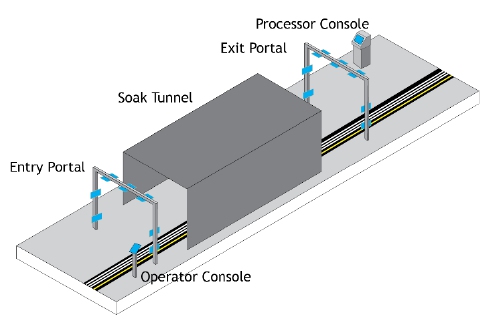
Figure 2. RFM5126 Moisture Intrusion Detection System automatically inspects vehicles for leaks at the end of the assembly process.
The RFM5126 turnkey system includes battery-free wireless moisture sensors and a highly capable processing system installed directly on moving assembly lines. Vehicles drive through system portals where antennas are mounted that wirelessly communicate with the sensors.
The moisture sensors are placed directly on the vehicle's metal chassis before trim stage (Figure 3).
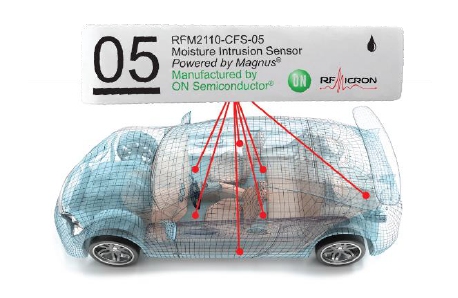
Figure 3. Sensors are placed directly on the vehicles' metal chassis at the pre-trim stage.
The system processes sensor data to determine if and where any leaks may be present. By positively identifying leak locations, the system reduces repair costs and saves time so that rework teams don't spend their time searching for leaks. The processed sensor data also provides critical statistical data that automakers can use to drive their quality control and analytics programs.
Critical statistical data includes:
- VIN (Vehicle Identification Number) data
- Vehicle wet/dry status
- Location of any leaks
- Chassis and trim style statistics
- Time and line statistics
- Assembly plan statistics
- Critical insights into materials/components
Wireless moisture sensors detect water using Smart Passive Sensing™ technology that allows them to operate without a local power source or batteries. Without batteries, the sensors are very thin and easily hidden under vehicle trim components. The sensors are sold under the Smart Passive Sensing™ brand by RFMicron as the RFM2110, and under the SPS™ brand by ON Semiconductor as the SPS1M001.
Wicking tails can be added to the sensors during installation to direct water (Figure 4). These thin, paper-like strips channel water toward the sensor using capillary action and allow the sensors to monitor moisture intrusion over a much larger area.
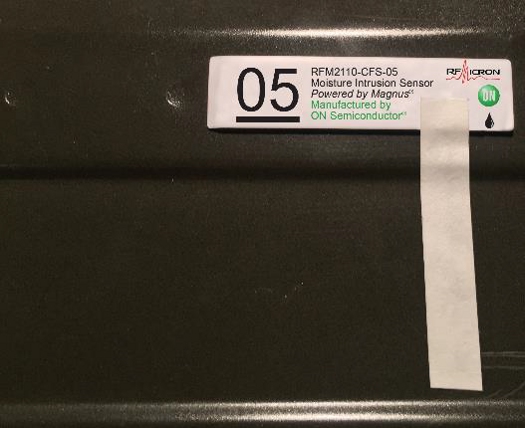
Figure 4. Thin wireless moisture sensor installed on bare chassis metal with optional wicking tail that extends the monitoring zone.
The battery-free sensors harness energy from the wireless radio frequency (RF) energy emitted by multiple antennas connected to the processing system's reader electronics. The antennas are mounted on a drive-through structure or "portal" directly over the moving assembly line (Figure 5). The reader electronics then cycle through the sensors to collect data for each vehicle.
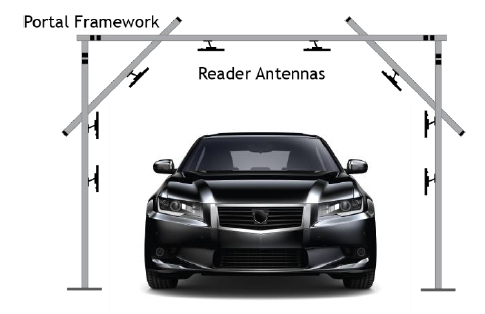
Figure 5. Drive-through portal configuration with portals on both ends of the water bath.
One portal and an operator station are placed at a pre-wash location before the soak test booth, and a second portal with the larger processor console is placed at a post-wash location after the soak test booth. Vehicles are scanned as they move through the portals, both before and after being subjected to high-pressure spray testing.
Data collected by the reader electronics is associated with the exact chassis VIN for easier data management. Automakers employ several chassis identification technologies such as barcode readers, and by integrating this functionality into the system, the RFM5126 system is flexible enough to accommodate most automaker needs.
All vehicle sensor data is processed at the console station. Differences between the pre-wash data and the post-wash data are used to determine wet or dry conditions per sensor location. The console stations provide direct feedback to operators when a leak is detected.
The system quickly and efficiently detects wet or dry conditions for an entire vehicle moving down the high-speed assembly line.
Each sensor includes an identification, or location, code associated with where that sensor has been placed on the chassis. The location code is used to alert line workers and rework teams exactly where to look for the issue once a leak has been detected. Isolating a leak to a specific location minimizes the amount of the interior removal needed to find and fix the issue.
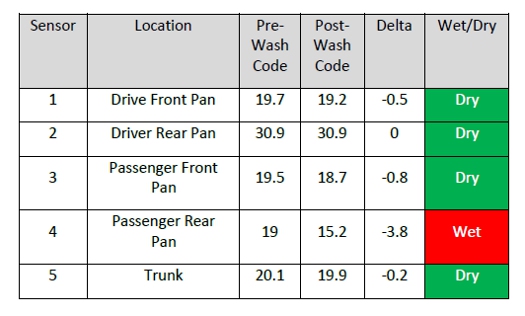
Table 1. Example data output includes: VIN XXX123, Inspection Line #1, DDMMYY: HH:MM, etc.
The RFM5126 system incorporates handheld sensor readers that provide a convenient way to interact with sensors when vehicles are away from the larger high-speed portals. This can be particularly helpful when verifying leak conditions in engineering lab settings and during rework.
The handheld software provides similar capabilities and network connectivity to the larger operator stations. All data is uploaded into the larger system database when the handheld readers are placed in their docking cradles.
System Hardware and Features
Hardware Components
The RFM5126 Moisture Intrusion Detection System includes all system hardware, structural components, and computing equipment needed to implement a complete automated leak detection system. The system is constructed with industrial-grade electronics and protected within water-tight enclosures. As challenging as high-pressure spray tests can be on vehicles, it can be equally challenging for unprotected electronics.
The system hardware includes:
- Pre-wash operator station
- Post-wash touchscreen control console
- Fault-tolerant servers and processors
- Redundant data storage & Ethernet network
- Industrial-grade electronics and NEMA enclosure
- Portal structures
- UHF Readers and antennas
- Handheld sensor scanners
- Barcode scanners
Software Features & Support
Comprehensive system software manages all data collection, data validation, storage, and processing.
System features include:
- Pre-wash and post-wash portal support
- Single drive-in, back-out portal support
- Handheld sensor reader w/ barcode scanner
- System managed VIN and sensor data linkage
- Real-time wet/dry analysis
- Console display of leak locations
- Manual/operator rework instructions
- Data retention local to the console station
- Data connection to OEM quality network
Vehicle monitoring data can also be sent directly to the automakers' quality management database. Accessing leak data is essential to deeper vehicle inspections and analyzing relevant trends.
The system provides business data to categorize leaks by assembly line, model, work shift, and other categories to help identify the root cause issues that affect vehicle assembly and lead to leaks in the first place. With a deeper understanding of leaks and their specific causes, automakers can feed this data back into their component engineering efforts to improve future vehicle designs.
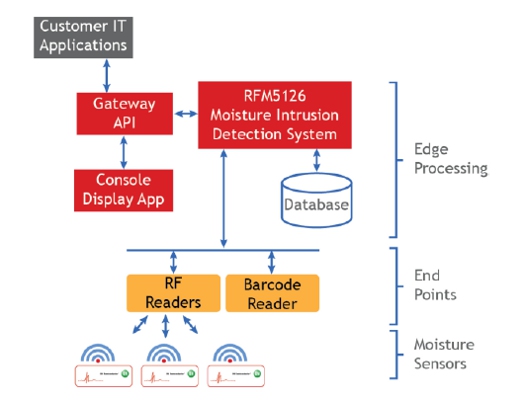
Figure 6. Turnkey System Software Architecture provides a comprehensive platform on which to add new features over time, including cognitive processing and analysis.
Overall Reliability and Repeatability
As a proven industry solution, this turnkey system has been rigorously tested while collecting data in both known WET and DRY vehicle locations to achieve a greater than 95% Gauge R&R (Reliability and Repeatability) accuracy rating. This is an industry-leading detection rate that far surpasses traditional manual inspection methods, which cannot meet a 90% rating.
Benefits & ROI
The RFM5126 system is purpose-designed to tackle the challenging vehicle assembly issues that escape the vehicle inspection process and lead to leaks that consumers are ultimately forced to address.
The fully automated system delivers multiple benefits for automakers, including:
Key benefits:
- No manual inspection labor required
- Real-time inspection results & data analytics
- No "touching" of the vehicle on the line
- Labor reduction of associated re-work
- Improved inspection accuracy
- Elimination of false positives
- Elimination of separate "audit style" testing
- Minimize leaky vehicle factory "escapes"
- Scalable for size and complexity of the vehicle
- Reduced warranty expense
- Improved consumer satisfaction
The ROI (Return on Investment) for automakers revolves around three main areas including reduced labor cost, fewer leaky vehicle "escapes," and improved consumer satisfaction.
Labor Cost Reduction
Labor cost reduction comes mainly from the automated nature of the inspection process. Identification of specific leak locations also reduces re-work costs and eliminates unnecessary vehicle disassembly when searching for leak sources using traditional inspection methods.
Manual inspection times commonly run 10 min. on the assembly line, with another 30 min. of re-work needed when leaks are found. The automated system eliminates up to 12 min. of overall labor per unit. Considering the cost of sensors, portal hardware, and processing costs, the overall per-vehicle savings is over $5 per unit with an hourly rate of $30 USD per operator.
Hidden Leak Remediation Costs
Watching profits leak away is painful. This is particularly true when warranty costs are the issue. The cost of repairing leak issues increases significantly once a vehicle leaves the factory. Repair costs are significantly higher in the field than they would be in the factory where highly skilled personnel are already on hand, as are the correct replacement components.
The cost of repairing a leak averages $5,700 once a vehicle makes it into the field. The reason for the high cost is that water tends to damage expensive electronics once it starts collecting inside the vehicle. An estimated 3% of vehicles leave the factory with leaks large enough to cause mold growth and equipment damage. This leads to more than $100 average leak remediation cost per vehicle. This hidden cost is ultimately passed on to consumers when purchasing new vehicles.
With over 70 million vehicles produced each year, these numbers point to a $15 billion industry-wide exposure. The ROI for automakers is significantly more attractive when including the cost of warranty repairs in their calculations.
Improved Quality & Brand Value
Perhaps the most important benefit of automated leak detection is the improvement in outgoing vehicle quality with an associated increase in brand value. Product quality improvements are critical drivers of improved consumer perception.
In Conclusion
ON Semiconductor and RFMicron provide an industry-proven, turn-key leak detection solution. The RFM5126 Moisture Intrusion Detection System wirelessly detects water intrusion into a vehicle and provides leak data analysis through industrial-grade automation hardware and software. Thin, battery-free wireless moisture detection sensors are placed under and behind vehicle trim in the critical water collection areas to pinpoint leaks. The fully automated portals with standalone operator stations and software are placed in-line with the vehicle assembly line and provide real-time inspection results. Back-end connectivity allows OEM's to track leak data over chassis models, model year, and assembly plants to improve quality and to then feed that data back into the design process for future models.
VIDEO: ON Semiconductor's Smart Passive Sensors are ultra-thin devices that dispense with the need to have a microcontroller or battery at each sensing node (with power, cost, and space benefits all resulting). They are able to work autonomously to sense key parameters (temperature, moisture, pressure, and proximity) in a highly energy-efficient manner that allows for all power needs to be satisfied through energy harvesting.
The turnkey system reduces per-vehicle labor cost by replacing manual inspection methods and reducing false-positive re-work time. The larger benefit is the reduction in hidden costs due to a reduction in leaky vehicle factory "escapes" that drive up warranty repair costs in the field. Improvements in automaker brand value align with automakers' quest for continuous quality improvements.
References & Further Material
1. Consumer Reports
Smart Passive Sensors and Smart Passive Sensing are legally held trademarks under RFMicron.
For more information on SPS technology and sensor operation, please see the below documents.
- PB027F01: RFM5126 Moisture Intrusion Portal System Product Brochure
- WP004F12: Automotive Water Intrusion Detection White Paper
- SPS1M001: SPSx Family Datasheet
- AND9209: APP Note - Chameleon™ Technology Enables Low-Cost Smart Passive Sensors
- AND9211: APP Note - Smart Passive Sensor Measurements
Source: ON Semiconductor
Published December 2017
Rate this article
View our terms of use and privacy policy
